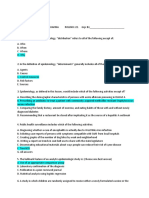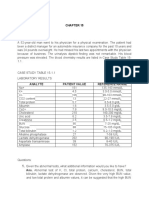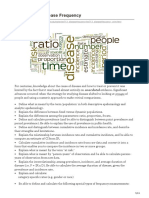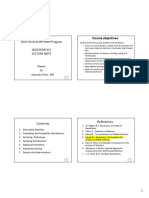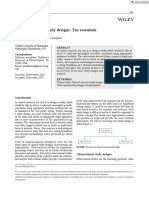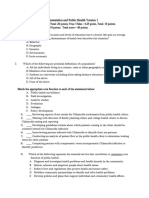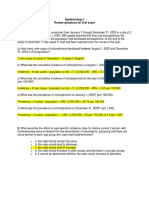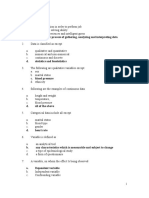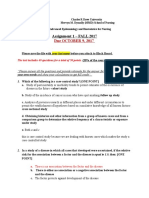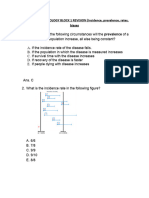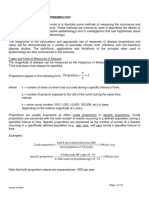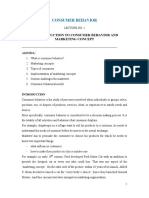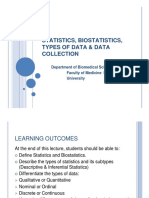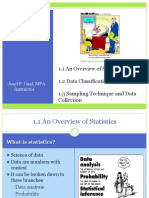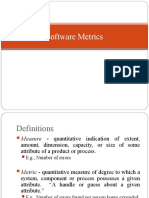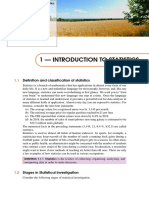Biostatistics
Bonnie Wang
Wang Bo Han
bonniecmu@hotmail.com
Dept. of Preventive Medicine
School of Public Health Administration
Liaoning Medical University
�Reference Book
Fundamentals of
Biostatistics(7th,
Edition)
Author Bernard
Rosner, Harvard
University
�Teaching plan
Chapter 1 General Overview
Chapter 2 Descriptive Statistics
Chapter 3 The normal curve
Chapter 4 Hypothesis Testing and t-test
Chapter 5 Analysis of variance (ANOVA)
Chapter 6 Chi square test
Chapter 7 Nonpapametric tests
Chapter 8 Correlation
Chapter 9 Simple linear regression
�Why medical students should
understand biostatistics ?
Basic requirement of medical research
To avoid misleading
To do our medical work smarter
�Chapter 1 General Overview
Statistics is a branch of science that deals with
the art of collecting, classifying, displaying,
analyzing, and interpreting results from
research.
The field of statistics has two main areas:
mathematical statistics and applied
statistics.
�Mathematical statistics concerns the
development of new methods of statistical
inference and requires detailed knowledge of
abstract mathematics for its implementation.
Applied statistics involves applying the
methods of mathematical statistics to specific
subject areas, such as economics, psychology,
and public health.
�Biostatistics
a portmanteau word made from biology and
statistics
The application of statistics to a wide range of
topics in biology.
Biostatistics is the branch of applied statistics
that applies statistical methods to medical and
biological problems.
�It is the science which deals with development
and application of the most appropriate methods
for the:
Collection of data.
Presentation of the collected data.
Analysis and interpretation of the results.
Making decisions on the basis of such
analysis
�The history of biostatistics
Pierre-Simon Laplace
(1749-1827)
Probability theory will
be widely used in
medical.
�Pierre-Charles-Alexandre Louis
(1787-1872)
Collected some patients
information to find the
treatment of typhoid
fever.
�Karl Pearson (1857-1936)
Pearson's work was all-embracing
in the wide application and
development of mathematical
statistics, and encompassed the
fields of biology, epidemiology,
anthropometry, medicine and
social history.
In 1901, with Weldon and Galton,
he founded the journal Biometrika
whose object was the development
of statistical theory. He edited this
journal until his death.
�Ronald A. Fisher 1890
An1962
English
statistician, evolutionary
biologist, eugenicist, and geneticist.
Among other things, Fisher is well
known for his contributions to statistics
by creating ANOVA (analysis of
variance), Fisher's exact test and
Fisher's equation.
Anders Hald called him "a genius who
almost single-handedly created the
foundations for modern statistical
science", while Richard Dawkins
named him "the greatest biologist
since Darwin".
�Challenge of modern statistical science
Public health:
Chronic non-communicable diseases--(survival analysis analysis of risk
factors)
Genetics and statistics
Population pharmacokinetics and statistics
Cost-effectiveness analysis
�What is BioStatistics?
Mathematics
rs
e
h
t
o
Biostatistics
Medicine
Basic
Clinical
Statistics
Collaborative Science
14
�Role of statisticians
To guide the design of an experiment or
survey prior to data collection
To analyze data using proper statistical
procedures and techniques
To present and interpret the results to
researchers and other decision makers
BY C. J. Chang
�Physiology of Research
Investigators View:
Truth in the
Truth in the
Findings
inference
inference
Universe
Study
in the Study
External
Validity
Internal
Validity
BY C. J. Chang
�Physiology of Research
Biostatisticians + Investigators View:
Research
Question
design
External
Validity
Study
Plan
implement
Actual
Study
Internal
Validity
BY C. J. Chang 17
�Physiology of Research
How Does it Work?
Truth in the
Truth in the
Findings
inference
inference
Universe
Study
in the Study
Research
Question
design
External
Validity
Study
Plan
implement
Actual
Study
Internal
Validity
BY C. J. Chang
�Collaborating Team Work
Principal Investigator
Biostatistician
Lab Scientist
Project Director
Research Nurse
Data Programmer
etc.
BY C. J. Chang
�What Do Biostatisticians Do?
Before Designing the Study:
Sample Size Calculation
Power Analysis
N=2987?!
BY C. J. Chang
�What Do Biostatisticians Do?
During the Study:
TEAM work
Questionnaire Design
Data Base Management
Quality Assurance/Quality Control
Monthly, Semi Annual, Annual Reports
Interim Data Analysis
etc...
BY C. J. Chang
�What Do Biostatisticians Do?
At the End of the Study:
Tips in Statistical analysis
Always start with descriptive statistics
Scatter plot
Use of appropriate variable
Use simple, efficient, and practical methods
Time independent vs. time dependent covariates
Not necessary advanced methods
Use most popular, acceptable statistical packages
Use universal recognizable data format
BY C. J. Chang
�What Do Biostatisticians Do?
Making Conclusions and Interpretation
How to control type-I, II errors
One answer for one hypothesis
Statistical vs. clinical significance
Over powered vs. under powered
Multiple comparisons
Over stretch statistical method
BY C. J. Chang 23
�Example: KSBPS
Kidney Stone - Blood Pressure Study
A study of the effects of Extracoporeal Shock Wave
Lithotripsy (ESWL) on Hypertension
PI : Michael Alderman, M.D.
Co-PI : Chee Jen Chang, Ph.D.
Co-PI : Jonathan Tobin, Ph.D.
Albert Einstein College of Medicine
Funded by National Electronic Manufacture Association
(NEMA) and approved by FDA in 1990
BY C. J. Chang 24
�KSBPS
Kidney Stone - Blood Pressure Study
Original Protocol:
Prospective two year follow up study for 4 years
Post marketing surveillance study
Phase IV study
Experimental study :
ESWL Extracorporeal Shock Wave Lithotripsy
vs. open surgery
Non randomized and non masked design study
Multi centers study
BY C. J. Chang
�KSBPS
Kidney Stone - Blood Pressure Study
Study Design:
Sample size :
900 control, 900 ESWL patients
Primary variables :
SBP/DBP at baseline, 6, 12, and 24 months
Secondary variables:
Renal functions at 0, 6, 12, and 24 months
Covariates:
Demographic variables, stone burden
BY C. J. Chang 26
�KSBPS
Kidney Stone - Blood Pressure Study
Hypothesis :
DBP difference between control
and ESWL groups is not greater
2.5 mmHg at 24 month
BY C. J. Chang 27
�KSBPS
Kidney Stone - Blood Pressure Study
Difficulties:
Patients selection bias
Patients follow-up visit interest is LOW
Renal function collection is costly and
unchanged
Different device type
Different technology in device type
New technology developed during the
study
BY C. J. Chang 28
�KSBPS
Kidney Stone - Blood Pressure Study
Statistical solutions to some difficulties:
Patients selection bias :
statistical analysis controlling
covariates
Patients follow-up visit interest is LOW:
reduce sample size, increase
effect size
BY C. J. Chang 29
�KSBPS
Kidney Stone - Blood Pressure Study
Statistical solutions to some difficulties:
Renal function collection is costly
and unchanged:
bioequivalence test to revise protocol
Different device type and technology
in device type:
stratified data analysis
BY C. J. Chang 30
�KSBPS
Kidney Stone - Blood Pressure Study
Can Statistics solve all the difficulties?
No !
New technology developed during
the study
Participants willingness
BY C. J. Chang 31
�KSBPS
Kidney Stone - Blood Pressure Study
In September, 1997, FDA issues:
Although an increase in blood pressure
may result after Lithotripsy for the treatment
of kidney stones, a 2 years prospective study
suggests that treatment with Lithotripsy will
not result in a difference in diastolic blood
pressure of 4 mmHg as compared to other
kidney stone therapies.
BY C. J. Chang 32
�What Do Biostatistician Do?
then, now and future
Methodology development
Consultant
Health- and bio- informatics
Research protocols review
Committee of Clinical Investigation (CCI)
Internal Review Board (IRB)
Regulatory review
BY C. J. Chang
�What Do Biostatistician Do?
then, now and future
Teaching (university, medical school)
Research (institute, foundation)
Government Agency (NIH, CDC)
Regulatory Agency (FDA)
Industry (Pharmaceutical, Biotech.)
Consulting (CRO)
BY C. J. Chang 34
�Basic conception
Populations and Samples
Homogeneity and variability
Type of the variable
Parameters and statistics
�Population
It is the largest collection of values of a
random variable for which we have an
interest at a particular time.
For example:
The weights of all the children enrolled in a
certain elementary school.
Populations may be finite or infinite.
36
��Sample
It is a part of a population.
For example:
The weights of only a fraction of
these children.
Text Book : Basic Concepts and
Methodology for the Health
Sciences
38
�Types of data
Constant
Variables:
Types of variables
Quantitative variables
Quantitative continuous
Quantitative descrete
Qualitative variables
Qualitative nominal
Qualitative ordinal
�Variable
It is a characteristic that takes on different values
in different persons, places, or things.
For example:
- heart rate,
- the heights of adult males,
- the weights of preschool children,
- the ages of patients seen in a dental clinic.
Text Book : Basic Concepts and
Methodology for the Health
Sciences
40
�Quantitative Variables
It can be measured in
the usual sense.
For example:
- the heights of adult
males,
- the weights of
preschool children,
- the ages of patients
seen in a
- dental clinic.
Qualitative Variables
Many characteristics are
not capable of being
measured. Some of them
can be ordered or ranked.
For example:
- classification of people into
socio-economic groups,
- social classes based on income,
education, etc.
41
�A discrete variable
is characterized by gaps
or interruptions in the
values that it can assume.
For example:
- The number of daily
admissions to a general
hospital,
- The number of decayed,
missing or filled teeth
per child in an
elementary school.
A continuous variable
can assume any value within a
specified relevant interval of values
assumed by the variable.
For example:
- Height,
- weight,
- skull circumference.
No matter how close together the
observed heights of two people,
we can find another person whose
height falls somewhere in
between.
42
�Statistics:
It is a descriptive measure computed from the
data of a sample.
Parameters:
It is a descriptive measure computed from the
data of a population.
Since it is difficult to measure a parameter from the
population, a sample is drawn of size n, whose values
are 1 , 2 , , n. From this data, we measure the
statistic.




